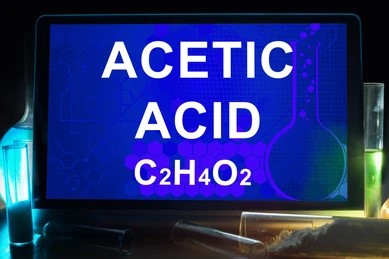An acidic, colourless liquid and organic compound with the chemical formula CH 3COOH. Industrially, acetic acid is used in the preparation of metal acetates, used in some printing processes; vinyl acetate, employed in the production of plastics; cellulose acetate, used in making photographic films and textiles; and volatile organic esters (such as ethyl and butyl acetates), widely used as solvents.

Acetic acid, also known as ethanoic acid, is a clear, colorless liquid with the chemical formula CH3COOH. It is a weak organic acid with a sour taste and a pungent odor, resembling vinegar. Acetic acid is one of the simplest carboxylic acids and has a wide range of industrial, commercial, and household applications.
Grade | Extra pure |
Purity | 30% |
CAS No. | 64-19-7 |
Molecular Formula | CH₃COOH |
Molecular Weight | 60.052 g/mol |
H.S. Code | 2915.2100 |
Shelf Life | 60 Months |
Grade | Extra pure |
Purity | 30% |
CAS No. | 64-19-7 |
Molecular Formula | CH₃COOH |
Molecular Weight | 60.052 g/mol |
H.S. Code | 2915.2100 |
Shelf Life | 60 Months |
Physical state at 20 °C | Liquid |
Colour | Colorless |
Odour | Stinging |
Relative density, liquid (water=1) | 1.039 g/cm3 |
Explosion limits – upper [%] | 19.9% (V) |
Explosion limits -lower [%] | 4.0% (V) |
Specifications | |
Appearance | Clear colorless liquid |
Assay (alkalimetric) | 29.0-31.0% |
Residue on evaporation | Max 0.01% |
Hazardous Statement: H226-H314 | |
Precaution Statement: P210-P280-P303+ P361+P353- P305+ P351+P338-P310 | |
| Physical state at 20 °C | Liquid |
| Colour | Colorless |
| Odour | Stinging |
| Relative density, liquid (water=1) | 1.039 g/cm3 |
| Explosion limits – upper [%] | 19.9% (V) |
| Explosion limits -lower [%] | 4.0% (V) |
| Specifications | |
| Appearance | Clear colorless liquid |
| Assay (alkalimetric) | 29.0-31.0% |
| Residue on evaporation | Max 0.01% |
| Hazardous Statement: H226-H314 | |
| Precaution Statement: P210-P280-P303+ P361+P353- P305+ P351+P338-P310 | |
Acetic acid is widely used in the food industry as a preservative, flavoring agent, and pH regulator. It is the main component of vinegar, which is used for pickling, salad dressings, and various culinary purposes.
Acetic acid serves as a precursor in the synthesis of numerous organic compounds, including acetate esters, acetic anhydride, and vinyl acetate monomer. These compounds are utilized in the production of adhesives, solvents, plastics, and pharmaceuticals.
Acetic acid is a key ingredient in the production of polyethylene terephthalate (PET) plastics, which are used in beverage bottles, food packaging, and synthetic fibers. It is also used in the manufacture of cellulose acetate, a versatile polymer used in films, textiles, and photographic film.
Concentrated acetic acid is corrosive to skin, eyes, and mucous membranes. Direct contact should be avoided, and appropriate personal protective equipment (PPE) should be worn when handling acetic acid.
Inhalation of acetic acid vapors can cause respiratory irritation and may exacerbate asthma or other respiratory conditions. Adequate ventilation should be provided in areas where acetic acid is used or stored.
Acetic acid is flammable and can form explosive mixtures with air. It should be stored away from heat sources, open flames, and oxidizing agents.
Whether you’re looking for raw materials for your manufacturing process or specialized chemicals for your industry, we’ve got you covered. What can we assist you with?